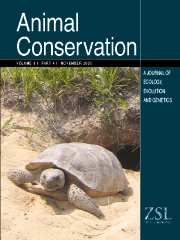Crossref Citations
This article has been cited by the following publications. This list is generated based on data provided by
Crossref.
Bustamante, A.V
Zambelli, A
De Lamo, D.A
von Thungen, J
and
Vidal-Rioja, L
2002.
Genetic variability of guanaco and llama populations in Argentina.
Small Ruminant Research,
Vol. 44,
Issue. 2,
p.
97.
Sarno, Ronald J.
Villalba, Lilian
Bonacic, Cristian
Gonzalez, Benito
Zapata, Beatriz
Mac Donald, David W.
O'Brien, Stephen J.
and
Johnson, Warren E.
2004.
Phylogeography and subspecies assessment of vicuñas in Chile and Bolivia utilizing mtDNA and microsatellite markers: implications for vicuña conservation and management.
Conservation Genetics,
Vol. 5,
Issue. 1,
p.
89.
Maté, M. L.
Bustamante, A.
Giovambattista, G.
de Lamo, D.
von Thüngen, J.
Zambelli, A.
and
Vidal‐Rioja, L.
2005.
Genetic diversity and differentiation of guanaco populations from Argentina inferred from microsatellite data.
Animal Genetics,
Vol. 36,
Issue. 4,
p.
316.
Franklin, William L.
and
Grigione, Melissa M.
2005.
The enigma of guanacos in the Falkland Islands: the legacy of John Hamilton.
Journal of Biogeography,
Vol. 32,
Issue. 4,
p.
661.
GONZÁLEZ, BENITO A.
PALMA, R. EDUARDO
ZAPATA, BEATRIZ
and
MARÍN, JUAN C.
2006.
Taxonomic and biogeographical status of guanaco Lama guanicoe (Artiodactyla, Camelidae).
Mammal Review,
Vol. 36,
Issue. 2,
p.
157.
Zapata, B.
González, B.A.
Marin, J.C.
Cabello, J.L.
Johnson, W.E.
and
Skewes, O.
2008.
Finding of polydactyly in a free-ranging guanaco (Lama guanicoe).
Small Ruminant Research,
Vol. 76,
Issue. 3,
p.
220.
Marín, Juan C.
Spotorno, Angel E.
González, Benito A.
Bonacic, Cristian
Wheeler, Jane C.
Casey, Ciara S.
Bruford, Michael W.
Palma, R. Eduardo
and
Poulin, Elie
2008.
Mitochondrial DNA Variation and Systematics of the Guanaco (Lama guanicoe, Artiodactyla: Camelidae).
Journal of Mammalogy,
Vol. 89,
Issue. 2,
p.
269.
Keppel, Gunnar
Lowe, Andrew J.
and
Possingham, Hugh P.
2009.
Changing perspectives on the biogeography of the tropical South Pacific: influences of dispersal, vicariance and extinction.
Journal of Biogeography,
Vol. 36,
Issue. 6,
p.
1035.
Marín, Juan C.
Saucedo, Cristian E.
Corti, Paulo
and
González, Benito A.
2009.
Application of DNA Forensic Techniques for Identifying Poached Guanacos (Lama guanicoe) in Chilean Patagonia*.
Journal of Forensic Sciences,
Vol. 54,
Issue. 5,
p.
1073.
Groeneveld, L. F.
Lenstra, J. A.
Eding, H.
Toro, M. A.
Scherf, B.
Pilling, D.
Negrini, R.
Finlay, E. K.
Jianlin, H.
Groeneveld, E.
and
Weigend, S.
2010.
Genetic diversity in farm animals – a review.
Animal Genetics,
Vol. 41,
Issue. s1,
p.
6.
Barreta, Julia
Iñiguez, Volga
Saavedra, Vladimir
Romero, Fernando
Callisaya, Ana María
Echalar, Joely
Gutiérrez-Gil, Beatriz
and
Arranz, Juan-José
2012.
Genetic diversity and population structure of Bolivian alpacas.
Small Ruminant Research,
Vol. 105,
Issue. 1-3,
p.
97.
KARL, STEPHEN A.
TOONEN, R. J.
GRANT, W. S.
and
BOWEN, B. W.
2012.
Common misconceptions in molecular ecology: echoes of the modern synthesis.
Molecular Ecology,
Vol. 21,
Issue. 17,
p.
4171.
Marin, Juan C.
González, Benito A.
Poulin, Elie
Casey, Ciara S.
and
Johnson, Warren E.
2013.
The influence of the aridAndean high plateau on the phylogeography and population genetics of guanaco (Lama guanicoe) inSouthAmerica.
Molecular Ecology,
Vol. 22,
Issue. 2,
p.
463.
Barreta, J.
Gutiérrez‐Gil, B.
Iñiguez, V.
Saavedra, V.
Chiri, R.
Latorre, E.
and
Arranz, J. J.
2013.
Analysis of mitochondrial DNA in Bolivian llama, alpaca and vicuna populations: a contribution to the phylogeny of the South American camelids.
Animal Genetics,
Vol. 44,
Issue. 2,
p.
158.
González, Benito A.
Orozco-terWengel, Pablo
von Borries, Rainer
Johnson, Warren E.
Franklin, William L.
Marín, Juan C.
and
Oleksyk, Taras K.
2014.
Maintenance of Genetic Diversity in an Introduced Island Population of Guanacos after Seven Decades and Two Severe Demographic Bottlenecks: Implications for Camelid Conservation.
PLoS ONE,
Vol. 9,
Issue. 3,
p.
e91714.
Chiang, Tzen-Yuh
Chen, Shu-Fang
Kato, Hidetoshi
Hwang, Chi-Chuan
Moore, Shann-Jye
Hsu, Tsai-Wen
and
Hung, Kuo-Hsiang
2014.
Temperate origin and diversification via southward colonization in Fatsia (Araliaceae), an insular endemic genus of the West Pacific Rim.
Tree Genetics & Genomes,
Vol. 10,
Issue. 5,
p.
1317.
Sarno, Ronald J.
Jennings, David E.
and
Franklin, William L.
2015.
Estimating effective population size of guanacos in Patagonia: an integrative approach for wildlife conservation.
Conservation Genetics,
Vol. 16,
Issue. 5,
p.
1167.
Moraga, Claudio A.
Funes, Martín C.
Pizarro, J. Cristóbal
Briceño, Cristóbal
and
Novaro, Andrés J.
2015.
Effects of livestock on guanacoLama guanicoedensity, movements and habitat selection in a forest–grassland mosaic in Tierra del Fuego, Chile.
Oryx,
Vol. 49,
Issue. 1,
p.
30.
Tonione, Maria A.
Fisher, Robert N.
Zhu, Catherine
and
Moritz, Craig
2016.
Deep divergence and structure in the Tropical Oceanic Pacific: a multilocus phylogeography of a widespread gekkonid lizard (Squamata: Gekkonidae:Gehyra oceanica).
Journal of Biogeography,
Vol. 43,
Issue. 2,
p.
268.
Casey, C. S.
Orozco-terWengel, P.
Yaya, K.
Kadwell, M.
Fernández, M.
Marín, J. C.
Rosadio, R.
Maturrano, L.
Hoces, D.
Hu, Y.
Wheeler, J. C.
and
Bruford, M. W.
2018.
Comparing genetic diversity and demographic history in co-distributed wild South American camelids.
Heredity,
Vol. 121,
Issue. 4,
p.
387.

